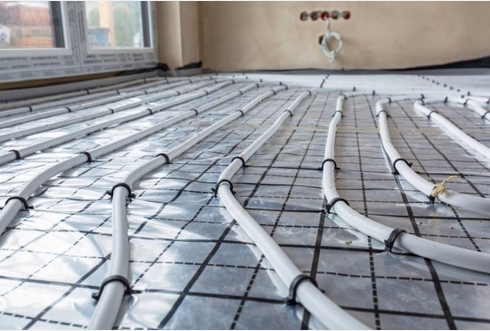If you live in Melbourne you know it can be unexpectedly cold. And there’s nothing worse than getting out of bed or stepping into the bathroom on cold floor or tiles. So it’s no surprise that many people have started installing underfloor heating. It is a popular way to increase the comfort of your room, and add value to your home.
But will your rug affect your underfloor heating?
When you install an underfloor heating system there are somethings you need to know. One thing you might not have considered is the way your rug interacts with the new heating system to increase or decrease your comfort. By knowing how a rug interacts with underfloor heating ahead of time will allow you to select an appropriate rug for your floor.
What is Underfloor Heating?
Underfloor heating is an increasingly popular home renovation choice. It has numerous benefits to offer, especially in large rooms or open-plan areas. This innovative type of heating is the perfect way to heat your space evenly without the need for radiators or ducted heating.
Underfloor heating comes in two main forms: electric systems and water systems. Electric systems use electrical cables to generate heat. Water systems, on the other hand, use a length of pipe set into the floor, a heat source, and a pump to pump water through the pipes which heats the floor.
Which option is right for your home will depend on a number of factors. Electric underfloor heating is easier to install and is ideal for fitting into existing properties. This means there’s less disruption when installing your heating system. However, they do have a minimum floor height required for fitting.
Water systems are much cheaper to run, however. They are perfect for large areas and give you the best multi-room options. However, unlike electric systems, water underfloor heating is better designed for new builds.
Rugs on Heated Floors
So can you put rugs on underfloor heated flooring? Well the efficiency of underfloor heating depends on a wide range of components. It’s wise to consider how suitable your rug is as a flooring material, not just as a decorative item. As gorgeous as your rug may be, it can act like a “blanket” and restrict the passage of heat into a room. Further, some flooring types have a particular top temperature restriction. That means, if you put a rug on your floor, it could potentially increase the flooring temperature beyond its limit.
However, there are some rugs that are suitable for use with underfloor heating. You should look for low thermal resistance rugs and give careful though to the thickness and size of the rug you intend to use. The blanket reaction the rug causes will also create a cooler spot within the room, making the room less comfortable. As a result, it is important to choose a rug that minimises the blanket effect as much as possible.
- The rug you choose must have low thermal resistance. This means that heat can more easily move through the rug and radiate into the room.
- The rug’s TOG (Thermal Overall Grade) rating should be between 1 and 2, and shouldn’t exceed 2.5. The lower the TOG rating, the lower the blanket effect.
- Your rug should be hessian-backed rather than felt-backed. Felt creates a thermal block and will stop heat from transferring from the floor into the rug.
- The rug shouldn’t be too large as this can reduce the overall effectiveness of the underfloor heating. While area rugs offer excellent benefits, if you have underfloor heating you should look at medium and smaller sized rugs.
- Rugs placed on underfloor heating must be made from natural fibres. Nylon and synthetic material rugs can melt if exposed to high temperatures for an extended period of time.
Flooring Recommendations for Underfloor Heating
The biggest difference between flooring materials and their suitability for use with underfloor heating relates to how quickly and efficiently the generated heat transfers to the floor surface.
Tile and Stone Flooring
Tile and stone are the best choices when it comes to underfloor heating. They have high thermal conductivity, which means that the heat will transfer to the surface quickly. Stone and tile also retain heat really well, making the system more efficient and saving you money. It is also safe to use an appropriate, small rug on these floors to suit your decorating needs and taste.
Wood Flooring
Wood flooring comes in a variety of different types and thermal properties, which means there’s a wide range of differences in their suitability for use with underfloor systems. The denser and thinner the floorboards are, the better they conduct heat and more suitable for underfloor heating. Engineered timber is considered the best type of wood floor to use with these systems.
However, when you place a rug on timber or wooden flooring with underfloor heating, the rug can trap the heat and push temperatures beyond temperature restrictions. When the heat is trapped, hot spots form underneath the rug. This will heat the wood up excessively and cause it to swell, twist and cup. Swelling is even more likely if moisture or humidity is present. The excessive heat can also cause the layers of the wood to delaminate. As a result, you need to be very careful when placing a rug on wooden flooring.
Rugs can and do work well with underfloor heating, as long as you take into consideration how the rug will interact with the flooring. By making the right choices you can have a room that is not only beautiful but incredibly comfortable.
